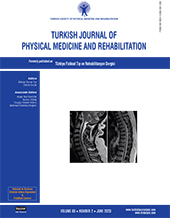Evaluation of the effect of chiropractic manipulative treatment on oxidative stress in sacroiliac joint dysfunction
2 Department of Internal Medicine, Kırıkkale University Faculty of Medicine, Kırıkkale, Turkey
3 Department of Internal Medicine, Division of Endocrinology and Metabolic Diseases, Kırıkkale University Faculty of Medicine, Kırıkkale, Turkey
4 Department of Medical Biochemistry, Yıldırım Beyazıt University Faculty of Medicine, Ankara, Turkey DOI : 10.5606/tftrd.2020.3301 Objectives: This study aims to investigate the effect of chiropractic manipulative treatment on sacroiliac joint dysfunction (SIJD) and its relationship to oxidative stress (OXS) parameters.
Patients and methods: Thirty-three patients diagnosed with SIJD (20 males, 13 females; mean age 36.3±9.7 years; range, 18 to 60 years) and 30 healthy volunteers (20 males, 10 females; mean age 36.4±12.2 years; range, 20 to 57 years) were included in this cross-sectional, case-control study conducted between February 2017 and September 2017. Manipulation was applied to the patients once a week for a duration of four weeks. The patients were evaluated at pre-treatment and one month after treatment with visual analog scale, SIJD test, and total thiol, native thiol, disulphide, and ischemia-modified albumin (IMA) as OXS indicators.
Results: Prior to treatment, we demonstrated that serum native thiol (μmol/L) and total thiol (μmol/L) levels in the patient group were lower compared to control subjects (p=0.03 and p=0.02, respectively). Serum IMA levels were higher in the patient group (p=0.01). There was no change in OXS parameters after manipulative treatment in the patient group.
Conclusion: Manipulation is useful in SIJD. Thiol/disulphide homeostasis and serum IMA levels may be used to measure the OXS in patients with SIJD.
Keywords : Chronic pain, ischemia-modified albumin, manipulative treatment, sacroiliac joint dysfunction, thiol/disulphide homeostasis

















